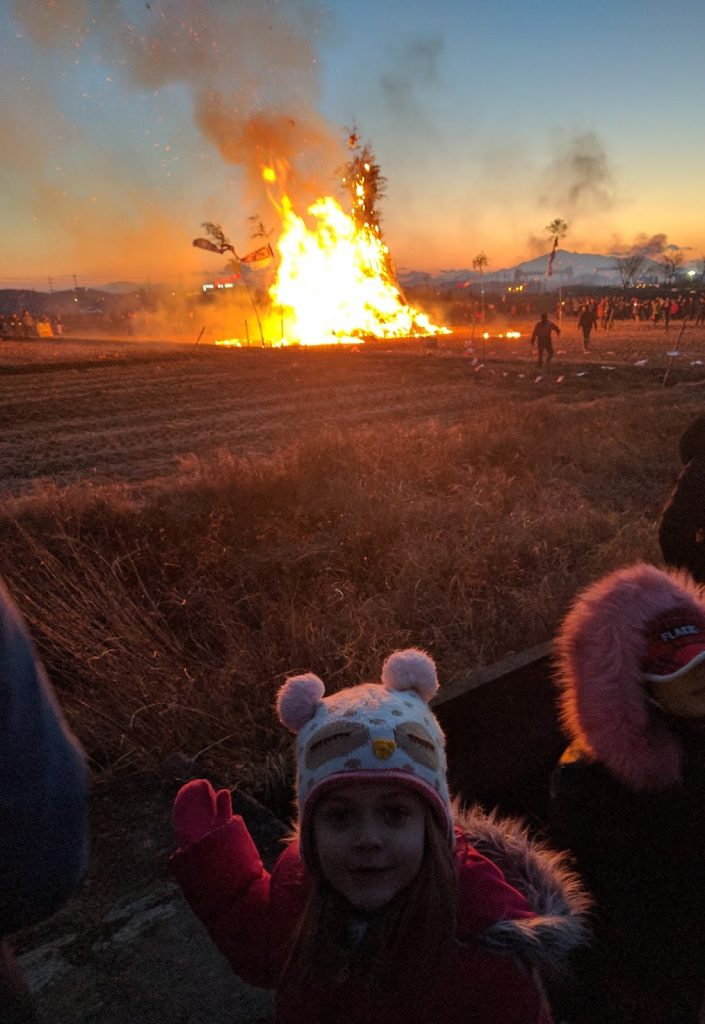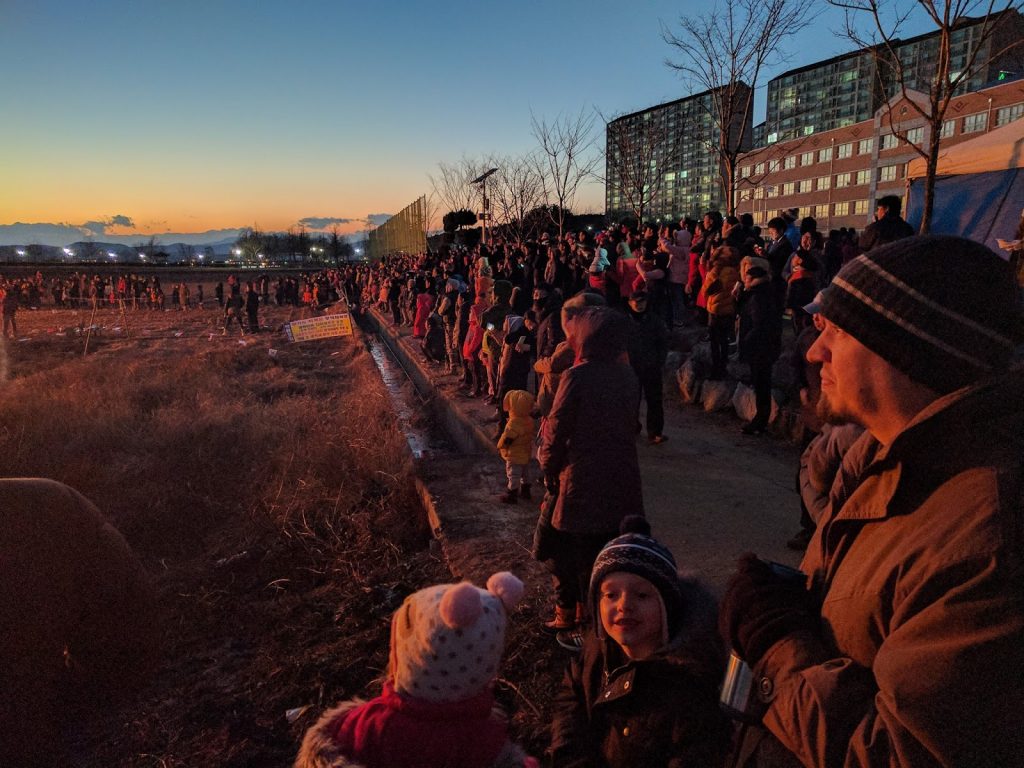Yesterday was Daeboreum, the Great Full Moon holiday. It celebrates the first full moon of the lunar year, and traditionally was a time when Koreans would pray for health and for a good harvest in the coming year.
We hadn’t heard of this holiday previously, but noticed last weekend that somebody was building a large bonfire in a field south of the school. Bonfires, or daljip (“moon house”) as the structure is called, are a central part of this holiday. Historically, every community would build one on the edge of their village. Daljip taeugi (“burning the moon house”) is the ritual of burning the daljip in order to bring fortune and prevent evil. It is set alight just as the full moon begins to rise. In the past, people would shout their wishes at the daljip, but today people write wishes on strips of paper and tie it to the daljip in the days leading up to Daeboreum.

There are a host of other rituals and foods traditionally associated with Daeboreum. Before breakfast, a family would drink a rice wine called gwibalgisul (“ear-sharpening liquor”). Drinking gwibalgisul at this time of day was believed to improve one’s hearing. Gwibalgisul was also believed to have the ability to dispel spirits, and was therefore served cold (rather than hot like most rice wines) to retain this ability. Everybody in the family would drink together; even children would “wet their lips.”
For breakfast, people would eat ogokbap (“five grain rice”) and sharing it with three neighbors was said to bring luck. (I can’t help but think this must have turned into a who-makes-the-best-ogokbap competition amongst the villagers.) I saw ogokbap in the store, so I assume it is still eaten today. Yaksik or yakbap (“medicinal rice”) is a yummy sounding concoction of sticky rice, honey, sesame oil, chestnuts, pine nuts, and jujubes. Both ogokbap and yakbap were nutritious meals for the middle of winter.
Nerdy historian side note: A record of Korean customs written in 1849 states that yakbap originated in the Silla Dynasty (57 BC – 935 AD). Another text from the early 1800s says yakbap is eaten on the 15th of the first lunar month (time of the first full moon) in a custom unique to Korea. The Samguk Yusa of 1281 describes a legend called Sageumgap about the origin of Ogiil, “Crow Memorial Day.” I’ve read a few different versions of this legend online, so I’m not sure what the original text says, but all involve a crow saving the life of King Soji of Silla on the 15th day of the first lunar month in 488 AD. This day became Ogiil, and the sticky rice offered to the crow in thanks became a traditional meal for that day. Given these records, many people trace the origins of yakbap to this time. My favorite version of the legend involves cryptic messages, intrigue, murder plots, manslaughter, and the queen and a monk getting frisky in a zither case. HISTORY IS AWESOME! Other records from the Joseon Dynasty (1392 – 1897 AD) attribute the origin of yakbap to Chinese envoys, but I’m going with the zither case version.

Bureom, or nuts, are another Daeboreum food. Koreans would crack open nuts with their teeth to keep their teeth healthy for the year (seems a tad counter-productive to me, depending on the nut, and I’m fairly certain they don’t do this anymore) and to prevent boils and skin infections. Apparently, the cracking sound of the nuts would also scare away evil spirits.
There are various traditional games and activities, as well: tug-of-war, kite flying, selling your heat, crossing a bridge at night to protect your legs for the year, and jwibulnori. The only one of these I witnessed myself was jwibulnori. In this “game,” children swing around a can full of blazing charcoal – wheee! – and it is said to help protect the new crops. It sounds like a parental nightmare, but jwibulnori actually serves a rather practical purpose. The fires are used to burn dry grass around rice paddies and fields in order to kill off insects and vermin. In fact, we saw several farmers around our area setting their fields on fire that afternoon.
Just before sunset on Daeboreum, people started gathering around the field with our local daljip. I say “our local daljip,” because we saw a couple other daljips around the area. (This whole region is very agricultural.) The road was lined with cars, people were walking over from the apartment complexes, food stalls were set up in the courtyard of the Korean elementary school, somebody was talking over a PA system, and a traditional Korean drum line was marching around the daljip.

We arrived just as the sun was setting and the moon was rising. We squeezed our way through the crowd, climbed down a few rocks, and found a spot along a concrete road that borders the field. Several men took torches to the base of the daljip and everybody cheered as the flames spread and grew.




The drummers continued drumming while the crowd snapped pictures with cell phones, and slowly started to disperse. It was pretty cold, and the wind quickly pushed the cold into my gloves and jeans, so I had little desire to linger either. I’m pretty sure the only warm ones around were the drummers, because they were playing frighteningly close to a 30-foot tower of flame.



I read an article in the Korea Times that expressed concerns over the fact that Valentine’s Day was seemingly becoming more popular among young Korean city-dwellers today than the other early-February holiday, Daeboreum. I suppose if you were a child living in Seoul, surrounded by nothing but high-rises, you would have no idea behind the meaning or purpose of jwibulnori. It would simply be a fun game spinning around cans of fire. But down here in the south, surrounded by farms, it all makes a lot more sense. In our local E-mart, the Valentine’s Day candy display sat right next to the Daeboreum nuts and grains display. I’m pretty sure they will continue celebrating Daeboreum here for years to come. After all, who doesn’t like standing around a massive bonfire?





